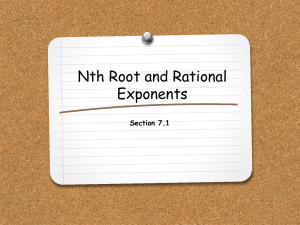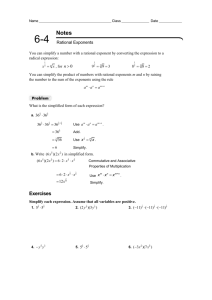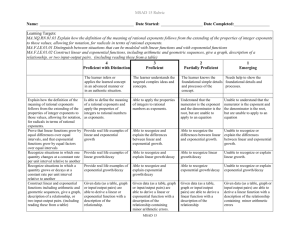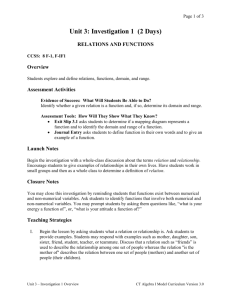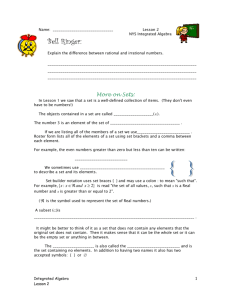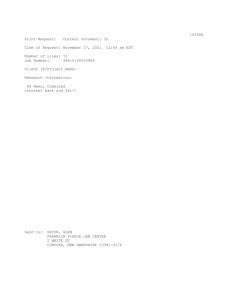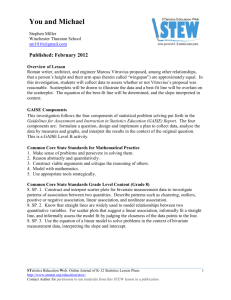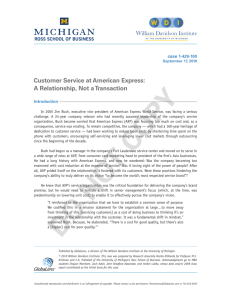Unit_4_Investigation_2_Overview
advertisement
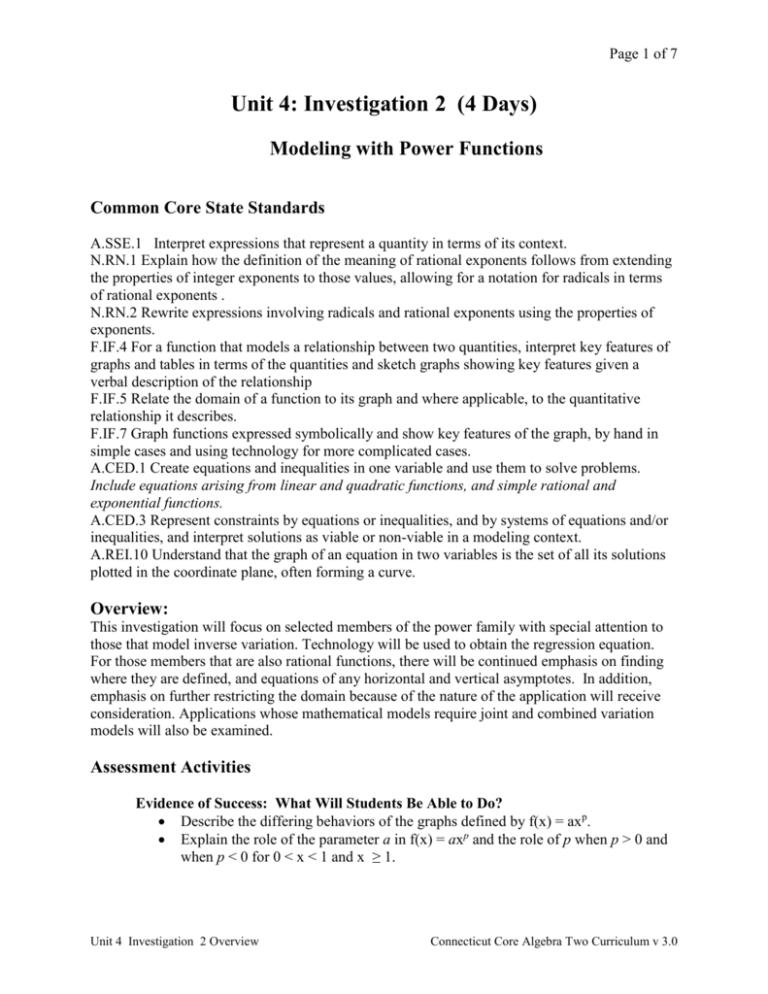
Page 1 of 7 Unit 4: Investigation 2 (4 Days) Modeling with Power Functions Common Core State Standards A.SSE.1 Interpret expressions that represent a quantity in terms of its context. N.RN.1 Explain how the definition of the meaning of rational exponents follows from extending the properties of integer exponents to those values, allowing for a notation for radicals in terms of rational exponents . N.RN.2 Rewrite expressions involving radicals and rational exponents using the properties of exponents. F.IF.4 For a function that models a relationship between two quantities, interpret key features of graphs and tables in terms of the quantities and sketch graphs showing key features given a verbal description of the relationship F.IF.5 Relate the domain of a function to its graph and where applicable, to the quantitative relationship it describes. F.IF.7 Graph functions expressed symbolically and show key features of the graph, by hand in simple cases and using technology for more complicated cases. A.CED.1 Create equations and inequalities in one variable and use them to solve problems. Include equations arising from linear and quadratic functions, and simple rational and exponential functions. A.CED.3 Represent constraints by equations or inequalities, and by systems of equations and/or inequalities, and interpret solutions as viable or non-viable in a modeling context. A.REI.10 Understand that the graph of an equation in two variables is the set of all its solutions plotted in the coordinate plane, often forming a curve. Overview: This investigation will focus on selected members of the power family with special attention to those that model inverse variation. Technology will be used to obtain the regression equation. For those members that are also rational functions, there will be continued emphasis on finding where they are defined, and equations of any horizontal and vertical asymptotes. In addition, emphasis on further restricting the domain because of the nature of the application will receive consideration. Applications whose mathematical models require joint and combined variation models will also be examined. Assessment Activities Evidence of Success: What Will Students Be Able to Do? Describe the differing behaviors of the graphs defined by f(x) = axp. Explain the role of the parameter a in f(x) = axp and the role of p when p > 0 and when p < 0 for 0 < x < 1 and x ≥ 1. Unit 4 Investigation 2 Overview Connecticut Core Algebra Two Curriculum v 3.0 Page 2 of 7 Explain why f(x) = axp also models a simple rational function when p is a negative integer and determine the domain, and equations of any vertical and horizontal asymptotes. Explain why f(x) = axp also models a simple polynomial function when p is a positive integer. Compare power, linear, and exponential functions. Model inverse variation, direct variation, joint or combined variation situations as appropriate by an equation . Assessment Strategies: How Will They Show What They Know? Exit slip 4.2.1 asks students to model variation problems. Exit Slip 4.2.2 asks student to make up a real world situation that can be modeled by direct, indirect, combined and/or joint variation, to provide a model and to explain why the model is appropriate. Exit Slip 4.2.3 asks student to explain why a given graph from the family f(x) = kxp for p a negative integer cannot be modeled by the particular given equation. Responses need to reflect an understanding of transformations and even/ odd behavior. Calculators should not be provided for this exit slip. Journal Prompt 1 asks students to explain why the graph of f(x) = x2/3 looks the way it does first by considering x2/3 = x(1/3)2 and then by considering x2/3 = (x2)1/3. Students will need to use good mathematical language from units 1 – 3. Journal Prompt 2 How do the parameters in the power family’s equation differ from those in the exponential family’s equation? Explain the significance of those differences. Activity Sheet 4.2.1 A and B will require students to pool data, enter it into lists, make a scatter plot graph and find the power regression equation and interpret results. Activity sheet 4.2.2 has applications of direct and indirect variation. Activity sheet 4.2.3 and 4.2.3a Pace vs Speed application will again use the power regression equation to model the data generated and in the alternate form data has been provided. Activity Sheet 4.2.4 will require students to use their graphers or other appropriate graphing technology to study and summarize the roles of the parameters a and p in the graphs of f(x) = axp. Activity 4.2.5 has additional application problems that also include joint variation. Launch Notes Students should come to class with the names of their birds, the average weight for the species and its average wingspan from Activity 4.1.7 Gathering Data on Bird Weights and Wingspans (Teacher Note: Answers for the weight and wingspan will differ some by gender and the web site used but Activity 4.2.1 ans has suggested answers. Form A has wingspan as the independent variable and Form B has weight as the independent variable.) The teacher can break students into groups and have each group record their information in one common table. These Unit 4 Investigation 2 Overview Connecticut Core Algebra Two Curriculum v 3.0 Page 3 of 7 can then be displayed on an overhead or document camera. Students can then put the data in lists L1 and L2 of a TI 83/84 or equivalent graphing technology. Have students alone or in pairs make a scatter plot on their grapher to assess whether the data is linear or not. It will not be linear and they should then consider what smooth curve could be used and which family they have studied can be used to model the data. The power family hopefully will be the ultimate choice and a power regression should be obtained. Teaching Strategies Activity sheet 4.2.1Aand/or B can be distributed once students have as a whole class obtained the power regression. Form A has wingspan as the independent variable and Form B has weight as the independent variable. Just one form can be used or both can be by splitting the class in two. If both forms are used students will have an examples of increasing graphs but with one concave up and the other concave down in quadrant I. Groups could be formed and within each group each group students should comment on the main trend and any exceptions to the trend and write a summary for the data. Birds that are outliers could be researched for discussion the next class period or during class if the internet is available within the classroom. This data is referred to again in Activity 5.5.5 so you may want to have students copy the lists to named lists so they can be saved and do not have to be entered again. Section II of Activity 5.5.5 is optional so at the very least it is suggested the teacher keep the lists in his or her calculator in named lists so L1 – L6 can remain free for use in other data analysis problems but the bird data remains available in case Activity 5.5.5 Section II is assigned later in the course. Group Activity. Activity 4.2.1A and/or B can be completed in small groups. Each group could be assigned to research one of the potential outliers for discussion the next class period. Activity sheet 4.2.2 with applications of direct and indirect variation can be assigned for homework but the teacher may want to do the volume, surface area and their ratio as a whole class or group activity first. Students will see that the surface area of a cube is directly proportional to the square of the length of a side and volume of a cube is directly proportional to the cube of the length of it edge. Students can explore the effect on the volume and surface area when an edge’s length is doubled. They will then explore the ratio of the surface area to volume. Differentiated Instruction (For Learners Needing More Help) Students can make tables of values to conjecture that as the length of a cube doubles its surface area quadruples but its volume increases by a factor of 8. They can also make a table to study the function that is defined to be the quotient of surface area to volume, with columns for edge length, surface area, volume and the surface area to volume ratio. They should see that as the length of an edge increases the ratio is decreasing and with guidance obtain the function f(x) = 6/x. Unit 4 Investigation 2 Overview Connecticut Core Algebra Two Curriculum v 3.0 Page 4 of 7 Differentiated Instruction (Enrichment) Students should be encouraged to evaluate the function s(x) = 6x2 at 2x and see that s(2x) = 6(4x2) and evaluate v(x) = x3 at 2x and get v(2x) = 8(x3) and lastly to calculate s(2x) / v(2x) = 3/x algebraically, noting that surface area and volume are indirectly (inversely) proportional. Volume and pressure are also indirectly related, V = 1/P. Students could research the units involved and answer why scuba divers are told to NEVER EVER hold their breath. Students can also be referred to Boyle’s Law. Note to teacher: Pressure in measured in atmospheres. One atmosphere, 1atm = 15 lb/sq inch. Fifteen pounds per square inch is the atmospheric pressure per square inch at the earth’s surface at sea level. Depth P V 0 1 1 33 2 1/2 66 3 1/3 99 4 1/4 So if you think of taking a balloon under the water, as you dive deeper, the pressure of the surrounding water increases and that will compress the air in the balloon. So as the depth in feet increases, the pressure increases and the volume in cubic feet decreases. Boyle’s Law states VP = k and in this situation k is 1. Remind students that scuba divers breathe pressurized air. So if you are scuba diving at 33 feet below the surface the surrounding pressure is 2 atm and if you breathe in deeply from your tank and hold your breath and rise, the pressure is decreasing and by surface is ½ of what it was (from 2 atm to 1 atm) so the volume in your lungs will double—ouch!!!!! If your school has a treadmill, students can gather their own data and use activity sheet 4.2.3 Pace vs Speed. Otherwise, in groups they can analyze the data provided with activity sheet 4.2.3a Pace vs Speed which has a table of data ready to use. Students could then make a plot of the data and fit a power function to the data. This application will need a model with a negative exponent. Pace is measured in how many minutes it takes to run or walk a mile. Speed is measured in miles per hour. Note that pace is typically given in minutes and seconds so students will have to convert to minutes and tenths of a minute. Exit slip 4.2.2 can be distributed. Group Activity 4.2.3 Pace vs Speed on a Treadmill or use activity sheet 4.2.3a Pace vs Speed depending upon whether you want to use prerecorded data or want students to gather their own data. Unit 4 Investigation 2 Overview Connecticut Core Algebra Two Curriculum v 3.0 Page 5 of 7 Differentiated Instruction (For Learners Needing More Help) Pace values can already be converted to minutes and tenths of a minute or the teacher can do a number of the conversions with students before having them work on their own. After getting a power regression a discussion of the domain and end behavior should take place in large group. If time permits, the homework problems can be discussed. Otherwise the homework can be collected and discussed at a later time. Activity 4.2.4 can be distributed and Case 1 (Power Family with p a natural number and 1 > x > 0 vs x > 1) can be assigned for homework . Students have already studied polynomial functions and should be able to answer the questions even if they have no access to grapher technology at home. Teachers may want to devote some class time to Case 2. (Power Family with p a positive rational number for 0 < p < 1, 1 > x > 0 vs x > 1 Case 2 can be done in class. (Teacher note: Since most of the time for applications we are graphing in the first quadrant focus has been for x > 0. But if students raise questions about x < 0 feel free to have students explore and for STEM students intending some mention of the graphical behavior when x < 0 should occur. ) Students should summarize the behavior in writing. Comparisons with the exponential family are then made and some more review with exponents is provided. Journal Prompt 1 Explain why the graph of f(x) = x2/3 looks the way it does first by considering x2/3 = x(1/3)2 and then by considering x2/3 = (x2)1/3. Use good mathematical language from units 1 – 3 . Students might say the graph of x1/3 plots in quadrants 1 and 3 and has symmetry with respect to the origin. When values are squared the piece in quadrant 3 reflects across the x-axis to quadrant 2 and we are left with a graph that has symmetry with respect the y-axis. If instead we start with y = x2 we have a graph that has symmetry with respect to the y-axis and a range that is non negative. When we then take the cube root of these positive values we will have a graph that still is symmetry to the y axis and that is in quadrants 1 and 2. Differentiated Instruction (Enrichment) Let x < 0 and examine the graphs of the power function family. Students should formulate some generalizations. Discuss the journal prompt. Make a final summary of the role of p in f(x) = axp. Have students discuss the cases when p = 0, p > 0 and p < 0. Then let p be a whole number only. Afterwards, let p be a negative number. Then consider the role of a again and relate to the defining equations of the other function families they have studied. Then ask them to consider f(x)= 1 + 1/x. What should the graph look like? Consider f(x)= 2 + 1/x . Then have them rewrite 1 + 1/x as (x + 1)/x and graph f(x)= (x + 1)/x . Students should pay special attention to the horizontal asymptotes. They should consider the definition of a rational function again. Do a number of examples. Exit slip 4.2.3 can be distributed. Unit 4 Investigation 2 Overview Connecticut Core Algebra Two Curriculum v 3.0 Page 6 of 7 Journal Prompt 2 How do the parameters in the power family’s equation differ from those in the exponential family’s equation.? Explain the significance of those differences. Students might say E(x) = abx and P(x) = axp and the coefficient a in both is a vertical stretch/compression factor. In the exponential the independent variable is in the exponent position of the power. In the power family the independent variable is in the base of the power. As we change the parameter b in the exponential if b > 1 we get increasing functions and the graphs are just more vertically stretched as we increase b. If 1 > b > 0 we get a decreasing function. Some of the applications in Activity 4.2.5 including a few with joint and combined variation models, should be discussed in class and then can be completed in class or for homework. But before students work on Activity 4.2.5 students could consider for example, the volume of a right circular cylinder with radius r and height h. Since V = π r2 h, so that k = π, the volume of the right circular cylinder is said to vary jointly as its height h and the square of its radius r. As an example of combined variation, when a model combines both direct and indirect variation, one could use the model for a safe load of a rectangular beam. The safe load S that the beam can support varies jointly as its width w and the square of its depth d and inversely as its length l . Hence S = kwd2 /l. Differentiated Instruction (For Learners Needing More Help) Activity 4.2.5 could be assigned in small groups or pairs while the teacher circulates. Closure Notes In large group, class should summarize the behavior of the power family and emphasize that when p is a negative integer these functions are also members of the rational function family. Student should also recognize that when p is a nonnegative integer the function is also a polynomial function. A Venn diagram could be used to symbolize these relationships or subset terminology could be used, for example that the polynomial function family is a subset of the rational function family. The power family and the rational family intersect. The linear family and quadratic families are disjoint. Vocabulary Continuous Discontinuous Combined variation Horizontal asymptote Joint variation Outlier Parameter Power regression Power function Vertical asymptote Rational function Unit 4 Investigation 2 Overview Connecticut Core Algebra Two Curriculum v 3.0 Page 7 of 7 Resources and Materials All activities should be assigned however it is not necessary to assign all problems in Activity 4.2.2 and 4.2.5. Many other applications of indirect variation exist so that activity 4.3.3 can be replaced with other data that may be of greater interest to students . The key is to have data or to generate data that need an indirect variation model. Activity Sheet 4.2.1A and/or B Data Table and Questions Regarding the Bird Wingspan and Weight Data Activity Sheet 4.2.2 Applications Problems Needing Direct and Indirect Variation Activity Sheet 4.2.3 and 4.2.3a Table for Pace vs Speed Data Activity Sheet 4.2.4 Graphing Investigation of the Roles of a and p for the Power Family Activity Sheet 4.2.5 Applications Problems that Include Joint Variation. Document camera or overhead projector TI 83/84 or access to Excel, Geogebra or equivalent technology One or more treadmills if available in the gym Table of selected bird species and the average wingspan and weight is included in 4.2.1 answer key. The website www.allaboutbirds.org has additional wingspan information . The National Geographic website has additional wingspan information. Unit 4 Investigation 2 Overview Connecticut Core Algebra Two Curriculum v 3.0

